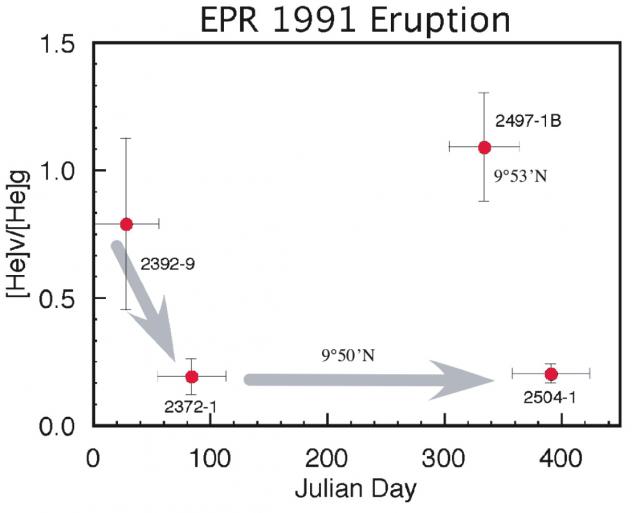Graham
DW Graham1, PJ Michael2 and KH Rubin3
1. College of Oceanic & Atmospheric Sciences, Oregon State University, Corvallis, OR 97331 dgraham@coas.oregonstate.edu
2. Dept. of Geosciences, The University of Tulsa, Tulsa, OK 74104
3. SOEST, University of Hawaii, Honolulu, HI 96822
The degassing of basalts and the injection of volatiles into hydrothermal systems are of central importance to mid-ocean ridge science. Virtually all ridge basalt magmas degas as they ascend through the oceanic crust because they are typically saturated or oversaturated with carbon dioxide. An unknown amount of the degassed CO2 is ultimately incorporated into hydrothermal vent community ecosystems through biochemical reactions. The composition of the basalt substrate and its volatile makeup also influence hydrothermal fluid compositions and the locations of vent communities.
We address basic questions about the linkages between degassing and ridge volcanic and seismic activity. We are measuring helium, argon and carbon isotope compositions, and He, Ar and CO2 concentrations, in the vesicles of basalt glasses from the 1991-1992 and 2005-2006 eruptions at the RIDGE 2000 ISS on the East Pacific Rise. These data can be used to relate volatile degassing to magma evolution and emplacement. The recent eruptions offer an opportunity to study magma recharge, to quantify the amount of pre-eruptive and syn-eruptive degassing, and to evaluate the extent to which mantle carbon may be incorporated into hydrothermal fluids and ultimately into seafloor ecosystems. The questions we address are:
1. What were the relative roles of pre-and syn-eruptive degassing during the EPR eruptions? How much CO2 was lost prior to versus during the eruptions?
2. Was there a transition from closed-system to open-system degassing? For example, are there systematic spatial variations in vesicle13C and 4He/40Ar*, or temporal trends in lavas dated by the 210Po-210Pb method?
3. Is there a relationship between gas contents and 210Pb-226Ra disequilibria? If so, can this constrain the mechanism and timing of gas loss?
4. Do the 13C and CO2/3He measurements provide evidence for direct volatile injection into the seafloor hydrothermal system?
Four Po-dated samples from the 1991-1992 eruption have been analyzed for He isotopes and He concentration in triplicate. The analyses were carried out by crushing to release He in the vesicles, by melting of the remaining crushed powders to obtain the “dissolved’ He concentration, and by melting of glass chunks to verify the He budget from the sum of crushing plus melted powder. All of the 1991-92 samples have the same 3He/4He (8.5 ±0.05 RA) and the same total He content (20-22 μcc/g). Our measured 3He/4He is similar to those previously reported by Gregg et al. [2000] for lava pillars from this area. Notably, our samples show a variation in the vapor-melt partitioning of He between vesicles and glass (Figure 1). This variation appears to show a trend with time, using the 210Po-210Pb eruption dates from Rubin et al. [1994]. The current data set is small, but it does suggest that the initial phase of the eruption involved magma that had the same amount of total gas as later stages of the eruption, but which was enriched in its vesicle gas proportion. We speculate that the eruption occurred either from a magma lens that had experienced some upward enrichment in the extent of vesiculation, or that ascent rate to the seafloor varied during the eruption, with the initial lava ascending more slowly and thereby having more time for vapor-melt re-equilibration.
Gregg TKP, DJ Fornari, MR Perfit, WI Ridley and MD Kurz (2000) Using submarine lava pillars to record mid-ocean ridge eruption dynamics. Earth Planet. Sci. Lett. 178, 195-214.
Rubin KH, JD Macdougall and MR Perfit (1994) 210Po-210Pb dating of recent volcanic eruptions on the sea floor: Nature 368, 841-844.

